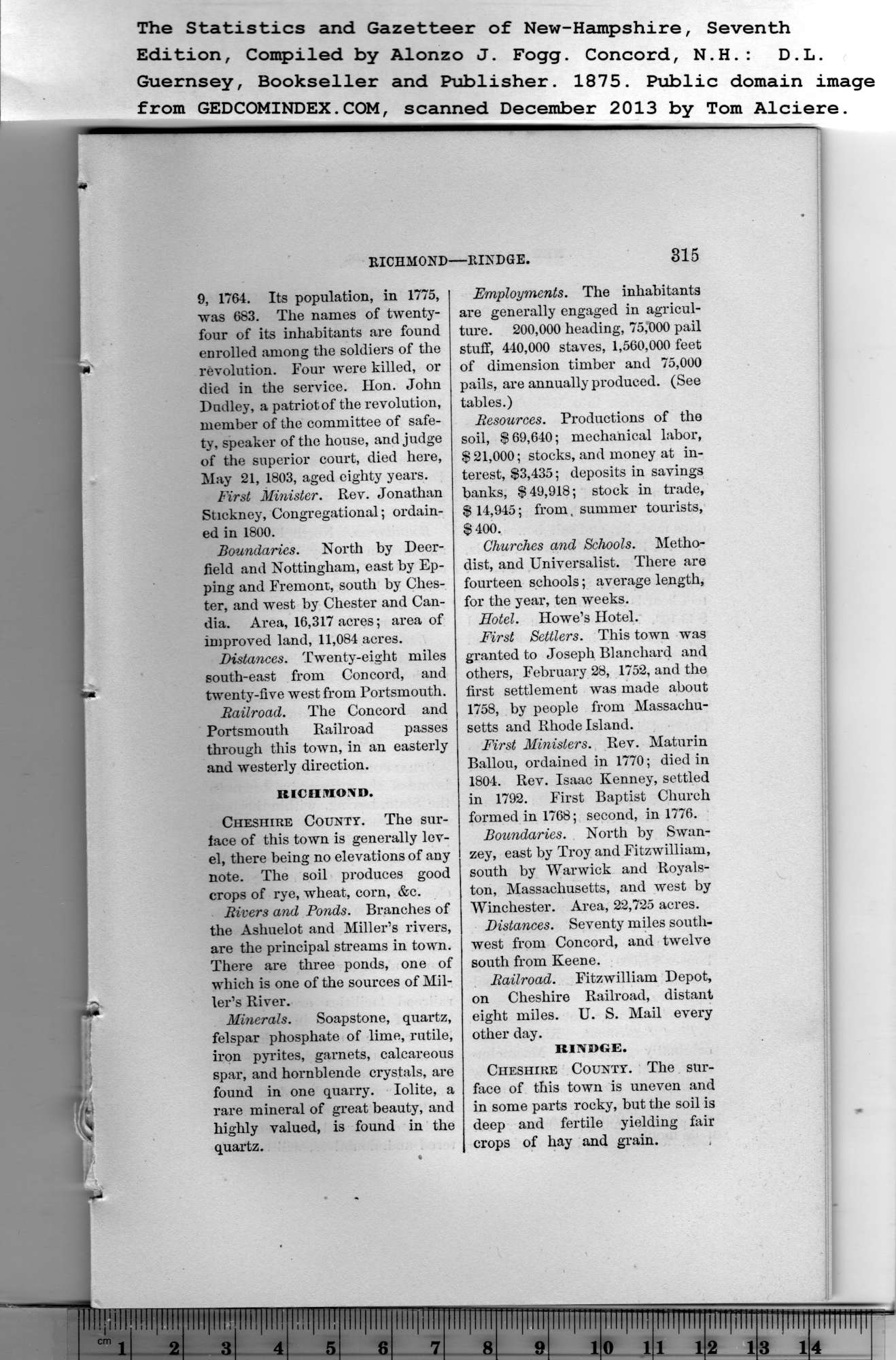|
9, 1764. Its population, in 1775,
was 683. The names of twenty-
four of its inhabitants are found
enrolled among the soldiers of the
revolution. Four were killed, or
died in the service. Hon. John
Dudley, a patriot of the revolution,
member of the committee of safe-
ty, speaker of the house, and judge
of the superior court, died here,
May 21, 1803, aged eighty years.
First Minister. Rev. Jonathan
Stickney, Congregational; ordain-
ed in 1800.
Boundaries. North by Deer-
field and Nottingham, east by Ep-
ping and Fremont, south by Ches-
ter, and west by Chester and Can-
dia. Area, 16,317 acres; area of
improved land, 11,084 acres.
Distances. Twenty-eight miles
south-east from Concord, and
twenty-five west from Portsmouth.
Railroad. The Concord and
Portsmouth Railroad passes
through this town, in an easterly
and westerly direction.
RICHMOND.
Cheshire County. The sur-
face of this town is generally lev-
el, there being no elevations of any
note. The soil produces good
crops of rye, wheat, corn, &c.
Rivers and Ponds. Branches of
the Ashuelot and Miller’s rivers,
are the principal streams in town.
There are three ponds, one of
which is one of the sources of Mil-
ler’s River.
Minerals. Soapstone, quartz,
felspar phosphate of lime, rutile,
iron pyrites, garnets, calcareous
spar, and hornblende crystals, are
found in one quarry. Iolite, a
rare mineral of great beauty, and
highly valued, is found in the
quartz. |
Employments. The inhabitants
are generally engaged in agricul-
ture. 200,000 heading, 75,000 pail
stuff, 440,000 staves, 1,560,000 feet
of dimension timber and 75,000
pails, are annually produced. (See
tables.)
Resources. Productions of the
soil, $69,640; mechanical labor,
$ 21,000; stocks, and money at in-
terest, $3,435; deposits in savings
banks, $49,918; stock in trade,
$ 14,945; from, summer tourists,
$400.
Churches and Schools. Metho-
dist, and Universalist. There are
fourteen schools; average length,
for the year, ten weeks.
Hotel. Howe’s Hotel.
First Settlers. This town was
granted to Joseph Blanchard and
others, February 28, 1752, and the
first settlement was made about
1758, by people from Massachu-
setts and Rhode Island.
First Ministers. Rev. Maturin
Ballou, ordained in 1770; died in
1804. Rev. Isaac Kenney, settled
in 1792. First Baptist Church
formed in 1768; second, in 1776.
Boundaries. North by Swan-
zey, east by Troy and Fitzwilliam,
south by Warwick and Royals-
ton, Massachusetts, and west by
Winchester. Area, 22,725 acres.
Distances. Seventy miles south-
west from Concord, and twelve
south from Keene.
Railroad. Fitzwilliam Depot,
on Cheshire Railroad, distant
eight miles. U. S. Mail every
other day.
RINDGE.
Cheshire County. The sur-
face of this town is uneven and
in some parts rocky, but the soil is
deep and fertile yielding fair
crops of hay and grain. |
